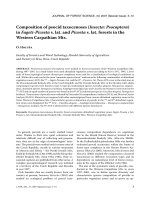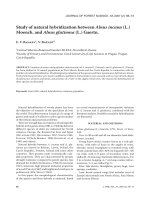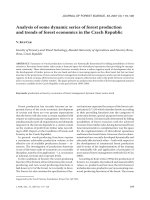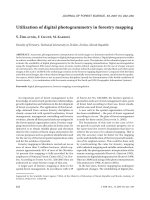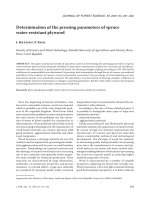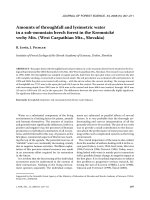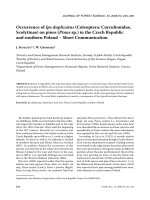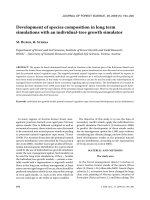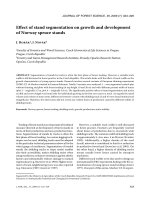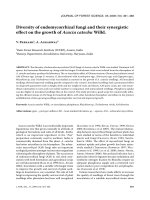Báo cáo lâm nghiệp: "Effect of climatic factors on the dynamics of radial increments of Norway spruce, European beech and sessile oak" potx
Bạn đang xem bản rút gọn của tài liệu. Xem và tải ngay bản đầy đủ của tài liệu tại đây (520.79 KB, 10 trang )
J. FOR. SCI., 57, 2011 (7): 293–302 293
JOURNAL OF FOREST SCIENCE, 57, 2011 (7): 293–302
Diameter and height increments are typical
growth characteristics of trees and they have a
seasonal character in our temperate climatic zone.
Individual dispositions of tree, site and climatic
conditions of each tree contribute to their forma-
tion. Possible damage to trees and change in the
growth conditions are frequent reasons for incre-
ment changes. It has been confirmed by many re-
sults of research published recently, e.g. in relation
with damage to forests by air pollutants and emis-
sions as well as the results of current research on
possible effects of climate change on forests. We
can cite the works on dendrochronology (F
1976; S 1983) and many others
that are aimed at studying the effect of climatic
factors on radial increments mainly of coniferous
tree species. V and B (1998) and O
and R (1999) studied annual rings of pine and
spruce in Lithuania, M (1998) studied pine
in Finland and F and W (1999a,
b; 2004) studied European black pine, Weymouth
pine and Douglas fir in Poland. Detailed research
was conducted in spruce, larch and Swiss stone
pine in the Alps, namely in the French part by R-
et al. (1998), in the Italian part of the Alps
by A et al. (1998) and in the Austrian
part by O and K (2000, 2003). In
Germany K (2004) studied seasonal dynam-
ics of diameter increment of fir and beech, G-
(2002) only of beech and R et al. (2010) of
spruce, pine and beech. V et al. (2004)
and N et al. (2010) studied the effect of cli-
matic factors on spruce and pine diameter incre-
ment in the Czech Republic. In Slovakia Ď
and P (1998) dealt with the issue of
climate and radial increment of pine, Š and
M (1999), P and I (2003) inves-
tigated Turkey oak and P et al. (2006, 2007)
dealt with sessile oak. Recently, K et al. (2008)
studied the effect of precipitation on radial incre-
ments of spruce, beech and pine trees in several
places in Scandinavia, Western and Central Europe.
According to their results it is not probable that the
higher increment of forests in Europe is a conse-
quence of higher precipitation. In the same study
M et al. (2008) did not clearly confirm the
Effect of climatic factors on the dynamics of radial
increments of Norway spruce, European beech
and sessile oak
R. P, J. M
National Forest Centre – Forest Research Institute in Zvolen, Zvolen, Slovakia
ABSTRACT: Correlations of increment indexes with average monthly temperatures and total monthly precipitation
were studied on annual ring series of 455 trees of Norway spruce (Picea abies [L.] Karst.), sessile oak (Quercus petrea
Liebl.) and European beech (Fagus sylvatica L.). Data on precipitation from the period 1901–2005 and on temperatures
from the period 1931–2005 were used. Statistically significant dependences with correlation coefficients in the range
of 0.2–0.5 were confirmed. All tree species react positively to precipitation mainly in June and July. An increase in
precipitation by 1 mm when compared with the long-term average results in an increase in increment index of spruce
almost by 0.13%. This index in oak and beech increases only by a half value of the value for spruce. Precipitation from
the second half of the vegetation period of the previous year is also important. Higher temperatures during the veg-
etation period affect increment changes mostly negatively. With temperature increase by 1°C, when compared with
the long-term average, the increment index of trees decreases by about 1–2%.
Keywords: annual ring analysis; climatic factors; radial increments; European beech; sessile oak; Norway spruce; Slovakia
294 J. FOR. SCI., 57, 2011 (7): 293–302
effect of precipitation even on the height growth of
trees. He did not confirm the effect of precipitation
even in the combination with increased content of
atmospheric nitrogen.
e aim of our paper is to study by means of
partial correlation dependences the effect of basic
climatic factors on increment changes in the long-
term growth process of spruce, oak and beech trees.
MATERIAL AND METHODS
Empirical material was collected in the central
part of Slovakia. Average monthly temperatures
from the years 1931–2005 and monthly precipita-
tion totals from the years 1901–2005 were obtained
from a climatic station at Sliač. Annual ring probes
were taken from dominant and co-dominant trees
of even-aged stands of spruce, beech and sessile
oak which grow to the distance of about 20–25 km
from the climatic station. At each tree only one in-
crement bore at breast height was taken at upside
of slope and other parameters such as tree diameter
at breast height and height of tree, tree class, dam-
age to the stem, crown defoliation, relative length
and crown isolation were determined. Annual ring
probes were taken in the period 2004–2006 from
455 trees in 18 pure stands according to tree spe-
cies with the following characteristics in Table 1.
e width of annual rings was measured with a
digital positiometer to the nearest ± 0.01 mm. e
annual ring series were synchronized, dated and
standardized. A simple method of the graphical
comparison of the highest increment minimums
and statistical testing of the increment trend par-
allelism by S (1983) and J
(1989) were used. e radial increments arranged in
annual ring series were synchronized in such a way
that the parallelism percents of increment trends
among all the individual trees from one stand were
calculated. An average increment curve was cal-
culated for the group of 4–7 trees within the same
stand which had the highest percent of parallelism
between each other. e increment curves of all
trees in the same stand were synchronized individu-
ally according to the average increment curve. eir
percent of parallelism is relatively high, for spru-
ce it is 61–98%, on average 80%, for oak 65–96%,
on average 79% and for beech 55–90%, it means
on average 77%. us spruce and oak have only the
slightly higher percent of parallelism than beech.
Regarding the high percent of parallelism of all tree
species we can state that their increment curves
are very similar and individual trees react equally
to the growth factors of a particular stand with
relatively high probability of 95%. It means that
individual trees in a particular year in comparison
with the previous year have equally increased or
decreased increment. In most cases the trees also
reach increment minimums in the same calendar
years. On the majority of the experimental plots it
was in the years 1905, 1923, 1947, 1962, 1974, 1993,
and 2000. Pine trees also reached increment mini-
mums at the same time as reported by P et al.
(2000). Standardization was performed by means
of the indexes of radial increments I
i
, which were
calculated as the ratio of real annual increments i
r
and their model values i
m
:
I
i
=
i
r
i
m
Model values were not derived by equalizing of
age increment trends but moving averages of ra-
dial increments were calculated. Moving averages
were calculated from four consecutive increments.
P et al. (2007) considered this procedure justi-
fied. Increment indexes were analyzed in detail and
their correlation from average monthly tempera-
tures and monthly precipitation totals was studied.
It is obvious in Fig. 1 that at the Sliač climatic
station annual precipitation totals ranged from
500 to 1,000 mm for the years 1901–2005 but for
the months of May–August they ranged only from
100to 500 mm. It is similar for air temperatures.
For the years 1931–2005 average annual tempera-
tures were about 6–10°C and for the vegetation pe-
riod 15–19°C. Regarding their long-term trend, it
is evident that they show relatively high variability
and provide good opportunities for studying their
effect on tree increments.
Table 1. Stands characteristic of research plots
Tree species
Number of
Age Site index Altitude
stands trees
Oak 8 190 70–170 22–30 400–650
Spruce 5 145 85–120 32–40 350–480
Beech 5 120 105–160 18–30 500–700
J. FOR. SCI., 57, 2011 (7): 293–302 295
RESULTS AND DISCUSSION
Pairwise correlations of the effect of climatic
factors on radial increments of trees
e effect of climatic factors on radial increments
of trees was studied in detail by means of corre-
lation analysis on standardized increment curves.
Pair correlation coefficients were calculated for
each tree which measure the linear relationship of
two variables. In our case they express the intensity
of the dependence of annual increment indexes on
monthly precipitation totals and average monthly
temperatures according to all months (January to
August) of the actual calendar year, i.e. the year
when the studied increment was formed as well as
for the last 8 months (May–December) of a pre-
vious year. Significance of correlation coefficients
was evaluated by means of statistical test at the
level of significance α = 0.05 with the number of
degrees of freedom n–2.
Significance of correlations for oak
e proportion of trees with statistically signifi-
cant correlation was different according to stands.
e lowest one was in stand No. 8, where only
about 5% and 25% of trees had a statistically signifi-
cant positive correlation of annual increments and
monthly precipitation in December and January.
For 10% and 45% of trees the correlation of precipi-
tation in September and August of the actual year
was also significant. e correlation between annual
increments and average monthly temperatures was
negligible. e highest correlations were found out
in stand No. 6, where precipitation in June and July
of the actual year and in September of the previous
year affected the increment of about 65–85% of trees
statistically significantly and positively. e intensity
of their correlation is not high as correlation coef-
ficients range only from 0.28 to 0.51. e negative
effect of precipitation and temperature is small and
illogical similarly like in the previous stand.
0
200
400
600
800
1,000
1,200
1900 1910 1920 1930 1940 1950 1960 1970 1980 1990 2000
Year
Precipitation totals (mm)
0
5
10
15
20
Average temperature (°C)
precipitation 1–12 precipitation 5–8
temperature 1–12 temperature 5–8
Fig. 1. Precipitation totals and average temperatures at Sliač climatic station
–30
– 20
– 10
0
10
20
30
40
50
M J J A S O N D J F M A M J J A
Month
Proportion of trees with significant
correlation coefficient (%)
–
30
–
20
–
10
0
10
20
30
40
50
M J J A S O N D J F M A M J J A
Month
Fig. 2. Proportions of oak trees with significant effects of precipitation (left) and temperature (right) on increment on
all plots. Single letters mean particular months continually in the previous year and in the actual year
296 J. FOR. SCI., 57, 2011 (7): 293–302
After summarizing the significant correlation co-
efficients from all 8 stands and 190 trees according
to Fig. 2 (left) we can state that precipitation in the
spring and summer season of the actual calendar
year affects annual increments significantly and
positively. In the period of March–July the propor-
tion of trees for which the precipitation is significant
increases by about 10–45%. Another important pe-
riod regarding precipitation is August–October of
a previous year. e proportion of trees which are
significantly influenced by precipitation is about
10–25%. e temperature affects radial increments
mostly negatively (Fig. 2, right). About 10–25% of
trees react negatively to average temperatures in
the period of July–September of the previous year
and in April of the actual year. March air tempera-
tures affect only 20% of trees positively.
Significance of correlations for spruce
Spruce stands have a different proportion of trees
with statistically significant correlation coefficients.
e lowest proportion of trees with the statistically
significant effect of precipitation on annual ring in-
dexes was found on plot No. 1. On this plot the June
and July precipitation of the actual year, i.e. the year
when the annual ring was formed, was most signifi-
cant for 80% and 70% of trees, whereas for 20% or
almost 40% of trees precipitation from the period
of August–September of the previous year was also
significant. e negative effect of higher tempera-
tures in September of the previous year on almost
90% of trees is unusual. e highest proportion of
trees with the statistically significant effect of pre-
cipitation on annual ring indexes was recorded in
stand No. 5. e June and July precipitation of the
actual year is most significant for 100% of trees and
for almost 80% of trees in this stand, and only for
10% or 5% of trees the precipitation in September
and October of the previous year is also significant.
Similarly to the previous stand, higher tempera-
tures in September of the previous year had a nega-
tive effect almost on 80% of trees.
Based on the proportion of the trees with signifi-
cant correlation coefficient (Fig. 3) in all 145 trees
in 5 stands together we may state with 95% prob-
ability that:
–About 85–90% of trees react positively to precipi-
tation in June and July,
–Only about 10% of trees react positively to pre-
cipitation in April, May or August,
–Only about 20% of trees react positively to pre-
cipitation in August and September of the previ-
ous year,
–Influence of monthly temperatures on diameter
increments of spruce is mostly negative,
– About 30% of trees react negatively to higher
temperatures in August of the actual year,
–About 40% of trees react negatively to high tem-
peratures in June, and almost 65% of trees to high
temperatures in September of the previous year,
– Only 30% of trees react positively to higher
monthly temperatures but only in March of the
actual year.
We can state from the obtained results that sum-
mer precipitation is very important for spruce
stands. Even very high supplies of winter and/
or of spring moisture are insufficient to cover
the high consumption of water during summer
months. We also confirmed a more significant but
negative effect of monthly temperatures on ra-
dial increments. A et al. (1998), M-
(1998), K et al. (2008) and M et al.
(2008) attributed higher but positive significance to
temperatures only in cold climatic zones or in high
mountainous locations, where it is relatively cold,
with permanent excess of precipitation and soil
moisture during the vegetation period.
–30
–20
–10
0
10
20
30
40
50
60
70
80
90
M J J A S O N D J F M A M J J A
Month
Proportion of trees with significant
correlation coefficient (%)
–70
–60
–50
–40
–30
–20
–10
0
10
20
30
40
M J J A S O N D J F M A M J J A
Month
Fig. 3. Proportions of spruce trees with significant effects of precipitation (left) and temperature (right) on increment
on all plots. Single letters mean particular months continually in the previous year and in the actual year
J. FOR. SCI., 57, 2011 (7): 293–302 297
Significance of correlations for beech
Similarly like for oak and spruce, the significance
of correlation coefficients for beech in the particu-
lar stands was considerably different. e lowest
proportion of trees with the statistically significant
effect of precipitation on increment indexes was re-
corded in stand No. 3. In this stand June and July
precipitation of the actual year was most significant
only for 20% of trees but precipitation in August of
the previous year was significant almost for 90% of
trees. We recorded the highest proportion of trees
with the statistically significant effect of precipita-
tion on increment indexes in stand No. 4. e June
and July precipitation of the actual year is most sig-
nificant almost for 100% of trees, and precipitation
in August and September of the previous year is
significant only for 30–60% of trees.
Based on the proportion of trees with statistically
significant correlation coefficient together for all
120 trees in 5 stands, which are illustrated in Fig. 4,
we can state with 95% probability that:
– About 40–50% of trees react positively to precipi-
tation in June and July,
– About 20% and 70% of trees react positively to
precipitation in July and August of the previous
year, effect of monthly temperatures on diameter
increment of beech trees is mostly negative,
– Only about 10–15% of trees react negatively to
higher temperatures in July until September of
the previous year.
Multiple correlation models of the effect
of climatic factors on radial increments of trees
After performing the detailed analysis of pair cor-
relation coefficients sets of monthly precipitation
amounts and average monthly air temperatures
were chosen which formed significant pair corre-
lations with increment indexes of a larger number
of trees on each research plot. A different set of
monthly precipitation amounts and temperatures
was chosen for each tree species:
Oak - - , P8ly, P9ly, P10ly, P5ay, P6ay, P7ay,
T7ly, T8ly, T9ly, T3ay, T4ay, - ,
Spruce - - , P8ly, P9ly, - , - , P6ay, P7ay,
- , - , T9ly, T3ay, - , T8ay,
Beech - P7ly, P8ly, - , - , - , P6ay, P7ay,
T7ly, T8ly, T9ly, - , - , - ,
Abbreviations: P – precipitation, T – temperature, number
– calendar month, ly – previous year, ay – actual year. For
example the abbreviation P8ly means precipitation for Au-
gust of the previous year, it means in the previous year when
increment was formed. As it obvious from the list of climatic
factors for the three tree species, precipitation in August of
the previous year and precipitation in June and July of the
actual year are significant. Regarding monthly temperatures,
only the temperature in September of the previous year is
significant for each tree species. e method of multiple
correlations was used for the derivation of the models of
dependence of increment indexes on selected climatic factors
together for all trees in each stand and together for every tree
species. Tables 2–4 present statistically significant parameters
and multiple correlation coefficients according to tree species.
e multicollinearity was tested by Scott’s criterion (K
2002) and it was not supported in any occasion.
Model for oak
According to the parameters of the model in
Table 2 it is obvious that a different combination
–50
–40
–30
–20
–10
0
10
20
30
40
50
60
70
M J J A S O N D J F M A M J J A
Month
Proportion of trees with significant
correlation coefficient (%)
–30
–20
–10
0
10
20
30
M J J A S O N D J F M A M J J A
Month
Fig. 4. Proportions of beech trees with significant effects of precipitation (left) and temperature (right) on increment
on all plots. Single letters mean particular months continually in the previous year and in the actual year
298 J. FOR. SCI., 57, 2011 (7): 293–302
of climatic factors is significant for each stand. For
most stands the precipitation in September and
October of the previous year and especially in May
and July of the actual year is significant. According
to negative parameters mainly in July and August
of the previous year we can state that the effect of
their average monthly temperatures is mostly neg-
ative. A positive effect on all plots was confirmed
only for March temperature in the actual year.
Based on the parameters of the model for 190 trees
of eight research plots we can state that only pre-
cipitation in August of the previous year was insig-
nificant. Although all dependences are statistically
significant, they are not very close. Multiple cor-
relation coefficients on 8 plots range from 0.203 to
0.526 and the whole set of oak trees has the value
0.363 only. Determination coefficient, which is its
square, has the value 0.132. It means that it is pos-
sible to explain only 13.2% of the total variability
of increment indexes by means of the model. e
other reasons are currently unknown.
Model for spruce
Spruce has a lower number of significant climatic
factors in the model. According to their list given
in Table 3 it is obvious that only precipitation and
temperature in September of the previous year are
not significant for all stands. In other cases pre-
cipitation in August of the previous year and in
the period of June–July of the actual year have a
positive effect on increments as well as tempera-
tures in March of the actual year. Regarding nega-
tive parameters of the temperature in September
of the previous year and August of the actual year
we can state that their effect is negative. e model
for 145 trees from five research plots has all sig-
nificant factors. Correlation dependences are not
very close even for spruce. ey range from 0.402
to 0.517 for individual stands, and for the whole set
of all spruce trees the value is 0.465. Coefficient of
determination has the value 0.216.
Model for beech
Beech has the same number of significant climat-
ic factors in the model as spruce. It is obvious from
Table 4 that only precipitation in August of the pre-
vious year and July of the actual year is significant
for all stands. In other cases precipitation in July
of the previous year and June of the actual year as
well as temperatures influence increments posi-
Table 2. Oak – correlation coefficients and parameters of a regression model of the dependence of increment indexes on significant climatic factors
Plot
Number
Correlation
coefficient
Model parameters for variable
trees
annual
rings
absolute P8ly P9ly P10ly P5ay P6ay P7ay T7ly T8ly T9ly T3ay T4ay
P01 25 1,773 0.298 1.004896 0.000638 0.000656 0.000243
–0.010894 0.007195
P02 24 1,726 0.429 1.914429
–0.000277 0.000558 0.000634 –0.000267 0.000495 –0.017220 –0.017445 –0.015837 0.006610 –0.018868
P03 23 1,656 0.492 1.657849 0.000968 0.000253 0.000683 0.000783
–0.011827 –0.021317 –0.016016 0.015628 –0.007234
P04 24 1,728 0.424 1.481642 0.000404 0.000707 0.000277 0.001102 0.000647
–0.016279 –0.016705 0.008094 –0.013275
P05 25 1,800 0.406 1.634443 0.000769 0.000523 0.000427
–0.010820 –0.012375 –0.014291 0.008638 –0.018124
P06 26 1,380 0.526 0.893821 0.000378 0.000907 0.000447 0.000625 0.001303 0.001075
–0.012275 –0.008693 0.009056 0.009358
P07 24 1,728 0.419 1.514752
–0.000278 0.000567 0.000465 0.000820 0.000560 0.000803 –0.011139 –0.024825 –0.006930 0.007451
P08 19 1,368 0.203 0.659786
–0.000371 0.016938 0.006922 0.008818
Together 190 13,159 0.363 1.392695 0.000596 0.000098 0.000672 0.000260 0.000576
–0.008487 –0.012873 –0.007211 0.009092 –0.010206
J. FOR. SCI., 57, 2011 (7): 293–302 299
tively in September of the previous year. Regarding
negative parameters in July–August of the previ-
ous year we can state that the effect of their aver-
age monthly temperatures is negative. e model
for all 120 trees from all 5 stands has all significant
factors. Correlation dependences are not very close
for beech as well. ey range from 0.216 to 0.422
in the particular stands, and for the whole set of all
trees the value is 0.341. Coefficient of determina-
tion has the value 0.116.
Intensity of the effect of climatic factors
ontrees increments
Based on the values of model parameters in
Tables2–4 we can evaluate and quantify also the
intensity of the effect of significant climatic fac-
tors on the increment of trees of the studied tree
species. Figs. 5 and 6 illustrate changes of incre-
ment indexes in percent in dependence on the unit
change of a particular climatic factor. Regarding
Fig. 5 (left) we can state that an increase of precipi-
tation in the period of July–October of the previous
year by 1mm will result in an increase of increment
indexes differently according to the respective tree
species within 0.01–0.11%. Precipitation in August
affects spruce and beech to the largest extent, while
precipitation in September affects oak to the great-
est extent. e effect of the previous year’s precipi-
tation on oak is only a half of the effect on beech.
e effect of precipitation on increment formed
in the same year is slightly higher. June and July
precipitation has the greatest effect (Fig. 5, right).
With its increase by 1 mm increment indexes also
increase by about 0.03–0.13%. Precipitation in June
has a greater effect on spruce and July precipitation
has a greater effect on beech and oak. Spruce reacts
to precipitation in both months by about one half
more intensively than beech and especially oak. It
is interesting that precipitation in May has about
the same effect on oak as precipitation in July.
e effect of temperatures of the previous year
is negative with one exception. Fig. 6 (left) illus-
trates that with an increase of average monthly
temperatures by 1°C the increments will decrease
by about 2.2%. is is most marked for spruce and
September temperatures. Higher July and August
temperatures have a higher negative effect on oak
and beech.
Table 3. Spruce – correlation coefficients and parameters of a regression model of the dependence of increment
indexes on significant climatic factors
Plot
Number
Correlation
coefficient
Model parameters for variable
trees
annual
rings
absolute P8ly P9ly P6ay P7ay T9ly T3ay T8ay
P01 25 1,821 0.484 1.664746 0.000496 0.000560 0.000938 0.000662 –0.043009 0.019164 –0.018901
P02 30 2,133 0.402 1.119192 0.000457 0.001320 0.000840 0.013136 –0.020775
P03 29 2,117 0.491 1.264223 0.000792 0.001627 0.001219 –0.021325 0.016136 –0.017332
P04 31 2,291 0.463 1.249972 0.000302 0.001486 0.000946 –0.022995 0.011584 –0.010935
P05 30 2,220 0.517 1.365978 0.000443 0.000543 0.001320 0.001175 –0.025552 0.025557 –0.020064
Together 145 10,567 0.465 1.333279 0.000478 0.000291 0.001329 0.000965 –0.022961 0.016812 –0.017370
0.00
0.02
0.04
0.06
0.08
0.10
0.12
July August September October
Change of increment index (%)
Spruc e
Beech
Oak
0.00
0.02
0.04
0.06
0.08
0.10
0.12
0.14
May June July
Fig. 5. e intensity of the effect of monthly precipitation during the vegetation period of the previous year (left) and
of the actual year (right) on increment indexes of tree species
300 J. FOR. SCI., 57, 2011 (7): 293–302
We can see (Fig. 6, right) that in the actual year
August temperatures have a negative effect on
spruce and April temperatures on oak. On the con-
trary, March temperatures have a positive effect on
the same tree species. eir change by 1°C will in-
crease the increment index by 0.9–1.7%.
CONCLUSIONS
After summarizing all obtained knowledge we
can state that statistically significant dependences,
though not very close, were confirmed between ba-
sic climatic factors and increment changes. eir
correlation coefficients are only 0.2–0.5. e inten-
sity of their effect on increment change is not high
either. All tree species react positively mainly to
precipitation during the vegetation period. Mainly
precipitation in June and July, known in Central
Europe as summer monsoons, is significant for in-
crement changes. With the increase of precipita-
tion by 1 mm, when compared with the long-term
average, the increment index of spruce increases
the most, almost by 0.13%. It is only a half of this
value for oak and beech. Precipitation from the sec-
ond half of the vegetation period of the previous
year is also significant. e effect of higher temper-
atures during the vegetation period on increment
changes is mostly negative. With their increase by
1°C, when compared with the long-term average,
the trees have mostly lower increment indexes by
about 1–2%. Higher temperatures in March affect
increment changes positively only in spruce and
oak. e increment increases by about 0.9–1.7%
with the temperature higher by 1°C.
e knowledge we have obtained is not surpris-
ing as many other authors attribute a greater sig-
nificance to higher precipitation under our climatic
conditions than to air temperature (A et
al. 1998; M et al. 1998; K et al. 2008;
M et al. 2008; N et al. 2010; R et
al. 2010). Higher precipitation is very important
mainly in lower and middle locations, where the
consumption of soil moisture, needed for evapo-
–2.5
–2.0
–1.5
–1.0
–0.5
0.0
0.5
1.0
July August September
Change of increment index (%)
Spruce Beech Oak
–2
.0
–1
.5
–1
.0
–0
.5
0.0
0.5
1.0
1.5
2.0
March April August
Fig. 6. e intensity of the effect of average monthly temperature during the vegetation period of the previous year
(left) and of the actual year (right) on increment indexes of tree species
Table 4. Beech – correlation coefficients and parameters of a regression model of the dependence of increment in-
dexes on significant climatic factors
Plot
Number
Correlation
coefficient
Model parameters for variable
trees
annual
rings
absolute P7ly P8ly P6ay P7ay T7ly T8ly T9ly
P01 25 1,825 0.387 1.053807 0.000776 0.001384 0.000530 –0.013553
P02 22 1,628 0.216 1.138951 0.000511 0.000220 0.000398 –0.012698
P03 24 1,776 0.393 1.056726 0.000653 0.001376 0.000375 –0.012991–0.006338 0.008768
P04 26 1,924 0.420 1.105563 0.000578 0.001432 0.001309 –0.020709
P05 23 1,702 0.422 1.091096 0.000798 0.001617 0.000665 0.000464 –0.024951 0.007815
Together 120 8,855 0.341 1.071975 0.000478 0.001115 0.000554 0.000629 –0.011522–0.008050 0.005463
J. FOR. SCI., 57, 2011 (7): 293–302 301
transpiration, is high during the vegetation pe-
riod. Even very high supplies of water in the soil
from winter and/or spring precipitation are insuf-
ficient to cover water consumption during sum-
mer months. Although the reaction of the studied
tree species to climatic factors is different, we can
state that spruce reacts in the best way and it is fol-
lowed by beech and oak. e main reason for this
fact may be anatomical dispositions of the spruce
tree. Its shallow root system is capable of absorb-
ing even a small amount of precipitation that pen-
etrates only to the surface of the soil profile. e
assimilatory apparatus of spruce is productive both
in early spring and in autumn, when broadleaved
tree species only start to form own leaves or the
leaves start to fall. Beech and mainly oak have
deeper root systems and water penetrates to these
root systems only from heavy precipitation. e
finding that mainly broadleaved tree species react
positively to precipitation in August and Septem-
ber of the previous year is also noteworthy. is
reaction of broadleaved tree species is probably
connected with greater supply of substances for the
more intensive formation of assimilatory organs in
the next year.
R eferences
A T., C M., R S., U C. (1998):
Long and short growth dynamics of Picea abies (L.) and
climatic factors: first results of an integrated study at the
timberline in eastern Italian Alps. Écologie, 29: 253–259.
Ď J., P A. (1998): Dendroclimatic model of
Scotch pine in Záhorska lowland. Acta Facultatis Forestalis
Zvolen-Slovakia, XL: 85–97. (in Slovak)
F E., W S. (1999a): Influence of thermal
and pluvial conditions on the radial increment of the Aus-
trian pine (Pinus nigra Arnold). Acta Agraria et Silvestria,
Silvestris, 37: 3–10. (in Polish)
F E., W S. (1999b): Influence of climatic
conditions on the annual ring increment of the Weymouth
pine (Pinus strobus L.). Zeszyty Naukowe Akademii Rol-
niczej, Krakow 362, Leśnictwo, 28: 17–25.
F E., W S. (2004): Dendroclimatological
regions of Douglas fir (Pseudotsuga menziesii Franco) in
western Poland. European Journal of Forest Research,
123: 39–43.
F H.C. (1976): Tree rings and climate. London, New
York, San Francisco, Academic Press.
G F. (2002): Wachstum von Altbuchen (Fagus syl-
vatica L.) auf einem Kalkstandort (Götingen/Sodderich)
in Abhängigkeit von der Witterung. III. Bohrkernanalysen.
Allgemeine Forst-und Jagdzeitung, 173: 117–122.
J J. (1989): Parallelism, testing its significance and utili-
zation in discipline annual ring analysis. Zprávy lesnického
výzkumu, 34: 42–45. (in Czech)
K H.P., S H., U R., P-M P.J.,
P J., M K.H., S R., R
K.E. (2008): Short-, medium-, and long-term variation in
radial growth, and the role of changes in the climatic water
balance for the growth of three tree species in Europe. In:
K H.P., K S A. (eds): Causes and
Consequences of Forest Growth Trends in Europe – Results
of the Recognition Project. EFI Research Report 21. Brill,
Leiden, Boston: 169–182.
K R. (2004): Seasonal dynamics of the diameter incre-
ment of fir (Abies alba Mill.) and beech (Fagus sylvatica L.)
in a mixed stand. Journal of Forest Science, 50: 149–160.
K K. (2002): QC. Expert 3.1, User’s manual. TryloByte,
Ltd., Pardubice.
M H. (1998): e suitability of height and radial
increment variation in Pinus sylvestris (L.) for expressing
environmental signals. Forest Ecology and Management,
112: 191–197.
M K.H., P J., S R., D
B., K H.P., P-M P.J., R K.E.,
S H. (2008): Historical development of nutrition
and climate and their relationships with tree growth for
three European tree species. In: K H.P., K
S A. (eds): Causes and Consequences of Forest
Growth Trends in Europe – Results of the Recognition Pro-
ject. EFI Research Report 21. Brill, Leiden, Boston: 83–125.
N J., S D., K D., D D. (2010):
e effect of different stand density on diameter growth
response in Scots pine stands in relation to climate situa-
tions. Journal of Forest Science, 56: 461–473.
O W., K W. (2000): Topographic influences
on radial growth of Scots pine (Pinus sylvestris L.) at small
spatial scales. Plant Ecology, 146: 231–240.
O W., K W. (2003): Einflus des Klimas und
der Hangexposition auf das Dickenwachstum der Zirbe
(Pinus cembra L.) im alpinen Waldgrenzökoton am Pat-
scherkofel (Tirol, Ősterreich). Centralblatt für das gesamte
Forstwesen, 120: 39–50.
O K., R J. (1999): Influence of climatic factors on an-
nual rings of conifers. Zeitschrift für Naturforschung, 54:
526–533.
P J., I J. (2003): Dynamics of diameter growth of
Turkey oak on loess loam in the dependence on climatic
factors. Lesnícky časopis – Forestry Journal, 49: 39–48.
P R., N V., M J. (2000): Diameter and height
increments of Scots pine trees damaged by crown. Journal
of Forest Science, 46: 515–525. (in Slovak)
P R., M J., N V. (2006): Some comments on
the study of the effect of climatic factors on radial incre-
ments of oak trees. In: Climate Change – Forest Ecosystems
& Landscape. Zvolen, National Forest Centre: 49–54.
302 J. FOR. SCI., 57, 2011 (7): 293–302
P R., B L., M J. (2007): Dynamics of radial
increments of oak due to climatic factors effect. Ekológia,
26: 295–304.
R C., P V., M R. (1998): Chang-
es in radial tree growth for Picea abies, Larix decidua, Pinus
cembra and Pinus uncinata near the alpine timberline since
1750. Trees, 13: 40–53.
R H., G D., G R. (2010): Beziehungen
zwischen Klima und Zuwachs, dargestellt am Beispiel von
Fichte, Kiefer und Buche in Sachsen. Allggemeine Forst-
und Jagdzeitung, 181: 21–35.
S F.H. (1983): Der Jahrring-Standort, Me-
thodik, Zeit und Klima in der Dendrochronologie. Bern,
Stuttgart, Verlag Paul Haupt.
Š Š., M A. (1999): Dendrochronological analysis
of diameter growth and increment of Turkey oak (Quercus
cerris L.) in Danube floodplain forests. Folia Oecologica,
25: 101–119.
V M., Z D., Š V., F-
V. (2004): Growth trends of spruce in the Orlické hory
Mts. Journal of Forest Science, 50: 67–77.
V A., B T. (1998): Dendroclimatological simi-
larities of Picea abies (L.) Karsten and Pinus sylvestris (L.).
Baltic Forestry, 1: 24–28.
Received for publication May 24, 2010
Accepted after corrections March 22, 2011
Corresponding author:
Ing. J M, CSc., National Forest Centre – Forest Research Institute in Zvolen, T. G. Masaryka 22,
960 92 Zvolen, Slovakia
e-mail:
